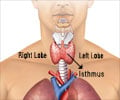According to research on the health effects of perchlorate, an inorganic anion and component of rocket fuel known to inhibit the thyroid’s ability to absorb iodine from the bloodstream…
Early last year, a National Academy of Sciences (NAS) panel concluded its review of research on the health effects of perchlorate, an inorganic anion and component of rocket fuel known to inhibit the thyroid’s ability to absorb iodine from the bloodstream, by recommending a new reference dose. The NAS also called for further research to identify safe exposure levels for sensitive subpopulations. Now, researchers at the Centers for Disease Control and Prevention (CDC) have released findings showing that American women, particularly those with low iodine intake, may have reduced thyroid function due to perchlorate exposure. Similar thyroid function changes were not found for men.
Perchlorate’s main use is as an oxidizer in solid rocket fuels. Other uses include explosives, road flares, and pyrotechnics, and the chemical can also form naturally in the atmosphere. A combination of these sources has led to the widespread presence of perchlorate in groundwater, drinking water, and foods including milk, vegetables, fruit, grain, and forage crops. Large doses of perchlorate have been shown to inhibit iodide uptake and reduce thyroid hormone production. Prolonged reduction in thyroid hormone can cause metabolic problems in adults and abnormal neurodevelopment during gestation and infancy.The researchers examined 2,299 men and women, aged 12 and older, who participated in the CDC’s National Health and Nutrition Examination Survey (NHANES) during 2001–2002. Examining the relationship between perchlorate concentrations in urine and concentrations of the thyroid hormones thyroxine (T4) and thyroid-stimulating hormone (TSH) in blood, researchers observed that perchlorate was a significant predictor of thyroid hormone levels in women, but not in men.
After seeing evidence of this gender difference, the authors focused their analysis on women. They categorized a total of 1,111 women into higher-iodine and lower-iodine groups using a cutpoint of 100 micrograms iodine per liter of urine (µg/L), then compared the women’s urinary perchlorate concentrations to their blood levels of T4 and TSH. They found a slight relationship between perchlorate concentrations and TSH for the higher-iodine group, but a much stronger one for perchlorate and both T4 and TSH in women in the lower-iodine group.
For the lower-iodine group, increased perchlorate was associated with less production of T4 and more production of TSH (which usually is produced to stimulate T4), suggesting competitive inhibition of thyroid iodine uptake by perchlorate. Women at the 50th percentile for urinary perchlorate had levels of 2.9 µg/L perchlorate, which predicted a decrease in T4 of 1.06 µg/dL; at the 95th percentile of perchlorate (13 µg/L), the predicted decrease in T4 was 1.64 µg/dL. Although the size of perchlorate’s predicted effect on T4 and TSH was small to moderate depending on the amount of perchlorate exposure, given that the normal range of T4 for women is between 5 and 12 µg/dL, these predicted reductions were significant and indicate that even small increases in perchlorate exposure may inhibit the thyroid’s ability to absorb iodine from the bloodstream.
In the United States, 36% of women have urinary iodine levels less than 100 µg/L, the same as the women in the lower-iodine group in the study. This study is the first to examine women with lower iodine levels for a potential effect of perchlorate on thyroid function. CDC researchers say that since this is the first time studying these women, another large study is needed to confirm these findings; they are planning that study.
Source-Newswise
SRM











